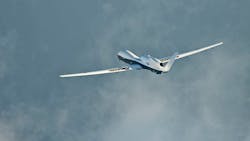Pentagon asks Northrop Grumman for additional surface-search radar systems for Triton maritime patrol UAV
PHILADELPHIA – Northrop Grumman Corp. will provide maritime search radar systems for U.S. Navy the MQ-4C Triton long-range ocean patrol unmanned aerial vehicle (UAV) under terms of a $375.8 million order announced Monday.
Officials of the U.S. Defense Logistics Agency (DLA) Aviation segment in Philadelphia are asking the Northrop Grumman Aerospace Systems segment in San Diego to provide the Triton UAV's Multi-Function Active Sensor (MFAS).
The MFAS is the Triton's maritime search radar that provides the UAV with a 360-degree view of a large geographic area while providing all-weather coverage for detecting, classifying, tracking, and identifying points of interest. MFAS is separate from the Triton's air-to-air radar.
The Triton performs maritime surveillance missions as long as 24 hours at altitudes of more than 10 miles to enable coverage out to 2,000 nautical miles. The UAV's suite of sensors can detect and classify different types of ships automatically.
Related: Triton maritime surveillance UAV technology upgrades: Navy's just getting started
The Triton is a crucial component of the Navy's 21st century strategy for conducting surveillance of surface ship and submarine traffic in the vast Pacific and other oceans around the globe. The MQ-4C Triton UAV works together with the Navy's P-8A Poseidon manned maritime patrol aircraft.
Along with the air-to-air and MFAS radar systems, the MQ-4C also will carry an electro-optical/infrared (EO/IR) sensor that will provide still imagery and full-motion video of potential threats; an electronic support measures package to identify and geolocate radar threat signals; and an Automatic Identification System (AIS) that will detect and track vessels equipped with AIS responders.
The MQ-4C Triton is designed to provide combat information to military authorities like the expeditionary strike group, carrier strike group, and the joint forces maritime component commander. The Triton air vehicle is based on the U.S. Air Force RQ-4B Global Hawk, while its sensors are based on components and systems already fielded in the U.S. military.
The large unmanned aircraft provides intelligence for large ocean areas to maintain the common operational and tactical picture of the maritime battle space. The Triton feeds intelligence, surveillance, and reconnaissance (ISR) data to the Global Information Grid (GIG), and can work alone or together with other aircraft and surface ships.
The MQ-4C Triton's ability to perform persistent ISR within a practical range of 2,000 nautical miles enables the P-8A aircraft to focus on anti-surface ship warfare, anti-submarine warfare (ASW), and multi-intelligence. The Triton can fly as far as 8,200 nautical miles without refueling.
Triton aircraft and support facilities are being based domestically at Point Mugu Naval Air Station near Ventura, Calif., and at Jacksonville Naval Air Station, Fla. Triton UAVs also will be forward-deployed to Kadena Air Base, Japan; Andersen Air Force Base, Guam; Sigonella Naval Air Station, Italy; as well as at installations on the islands of Hawaii and Diego Garcia.
On this order Northrop Grumman will do the work in California, and should be finished by December 2025. For more information contact Northrop Grumman Aerospace Systems online www.northropgrumman.com, or the Defense Logistics Agency Aviation at www.dla.mil/Aviation.
About the Author
John Keller
Editor-in-Chief
John Keller is the Editor-in-Chief, Military & Aerospace Electronics Magazine--provides extensive coverage and analysis of enabling electronics and optoelectronic technologies in military, space and commercial aviation applications. John has been a member of the Military & Aerospace Electronics staff since 1989 and chief editor since 1995.

